In this issue:
2018 air fee
– early estimate
To assist facilities in
planning their expenditures, the MPCA has estimated the 2018 air fee based on
draft 2016 billable facility air emissions. The early estimate of the 2018 air
fee is $108 per ton of billable emissions, very close to the 2017 fee for 2015
billable emissions.
This estimated air fee amount
per ton of billable emissions was determined by dividing the estimated amount
of money the MN State Legislature will appropriate for the MPCA air program by
the total billable emissions. The estimated 2018 air fee closely corresponds to
the 2017 fee because there was an estimated 2.7% increase of billable facility
emissions between 2015 and 2016, but also an expected 2.5% increase in the
Legislature’s air program appropriation. Historic trends from 2006 (2004
emissions) to 2018 (2016 emissions) have shown a decrease of 61% for billable
emissions and an increase in air program appropriations of 40%.
As both the total billable
emissions and the air program appropriation are not final, the estimated 2018 air
fee is draft and subject to change. Invoices based on the final 2016 air
emissions and air program appropriation will be mailed in the spring of 2018.
For
more information, see the MPCA Emission Inventory Fee webpage.
The MPCA has serious concerns with a bill in the Legislature
that requires legislative
appropriation of funds Minnesota receives from the national Volkswagen
Settlement. Minnesota is in line to receive $47 million from this
settlement. Recently MPCA Commissioner
John Linc Stine sent a letter to legislative leaders stating strong opposition
to the proposed legislation, as it could adversely affect Minnesota’s ability
to obtain these funds.
The VW Settlement
is the result of a federal court case against Volkswagen Company, which
intentionally tampered with diesel engines causing tailpipe emissions that were
more than 30 times the standard for nitrogen oxides. In Minnesota, these faulty
engines caused the illegal emission of more than 600 tons of nitrogen oxides
over seven years – equivalent to putting an additional 300,000 cars on
Minnesota’s roads.
The court
required states to show they have “full legal authority to receive and direct the payment of the settlement funds,” and Governor Dayton has delegated that
authority to the MPCA. The settlement
lists 10 specific categories of projects the money must go to. However, the proposed bill includes
legislative review/approval of funding, and specifies that some of what
Minnesota receives must be used for certain types of projects that are not
listed in the settlement, for example propane bus infrastructure. The federal trustee must approve all
disbursement of funds from the settlement, and MPCA is concerned this bill
could delay the state’s receipt of funds or even make the state ineligible to
receive funds.
States are required under the settlement to develop and
submit plans for how they intend to spend their funds, and the MPCA has been actively
seeking public and stakeholder input for several months to develop Minnesota’s
plan. You can sign up to receive updates
on matters related to the VW settlement and provide comments to the MPCA on how
you feel the money should be spent on the VW settlement webpage.

The federal government sued Volkswagen for violating the
Clean Air Act by selling diesel cars and sport utility vehicles that emit air
pollution over the legal limit, and cheating on federal emission tests to hide
the excess pollution. Volkswagen agreed
to settle the allegations last fall. The
affected vehicles exceed federal emission limits for nitrogen oxides (NOx), a
group of pollutants that harm public health and contribute to ground-level
ozone (smog) formation.
As part of the settlement, states are eligible to receive
funds to pay part of the cost of projects to reduce diesel emissions from
vehicles and to install electric vehicle infrastructure. The states must submit plans for their use of
the funds, and the MPCA is developing a plan that reflects Minnesota’s
priorities for spending these funds and a program for selecting among proposed projects. We’ve had three public meetings, but we want
to hear from more Minnesotans.
What do YOU think should be Minnesota’s priorities as we
develop our plan? Complete this quick survey to share your
thoughts. To learn more about the VW
settlement and its effects in Minnesota visit our website.
|

Poor air quality can occur any time of the year in any part
of Minnesota. While it’s true that the
majority of days in Minnesota have healthy air quality, those who are sensitive
to air pollution know it only takes one day with unhealthy air to impact a
life. To match this reality, the
Minnesota Pollution Control Agency is getting ready to overhaul its Air Quality
Index (AQI) forecasting program.
Previously limited to the Twin Cities and Rochester, this
summer the MPCA will be forecasting air quality conditions statewide. From the
shores of Lake Superior, to the western prairies, to the Mississippi River
Valley, MPCA will have an air quality forecast to serve you. Starting June 1, the MPCA will issue daily
air quality forecasts for 17 locations across
the state. This means people who may be
sensitive to elevated levels of air pollution – including children, the
elderly, and those with respiratory problems – can be better prepared to
protect their health.
The AQI forecasts will now look out three days, and will
focus on the color-coded, health-based AQI categories set by the Environmental
Protection Agency. Green means the air
is expected to be healthy for all, yellow means moderate, and orange means
conditions are unhealthy for sensitive groups.
Red, rarely seen in Minnesota, means the air is unhealthy for all. The
MPCA will continue to issue air quality alerts whenever the AQI is expected to
be in either the orange or red categories.
To expand the reach of air quality alerts, the MPCA has
partnered with the six National Weather Service offices that serve Minnesota to
include air quality alerts in their watch/warning/advisory dissemination
system. In addition to the NWS helping to get the word out, the Minnesota
Department of Transportation will also continue providing notifications of air
quality alerts via the travel alert signs familiar to commuters across the Twin
Cities.
All air quality alerts will also include new language
developed by the MPCA and the Minnesota Department of Health to help citizens
understand the potential health impacts of poor air quality and tips for
reducing air pollution. If you or people
you know are sensitive to air quality, the MPCA encourages you to become “air
aware” by signing
up to receive air quality forecasts and alerts. You can find additional information about health and
Minnesota’s indoor and outdoor air quality at www.beairawaremn.org.
|
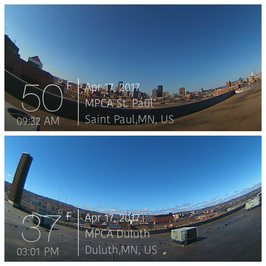
As MPCA’s air quality meteorologists would tell you, air
quality and weather are intricately connected. So to keep an eye on the sky,
two new “aircams” have been installed at the MPCA offices in Saint Paul and
Duluth. These aircams will provide not only great views of Saint Paul and
downtown Duluth, but also time-lapse videos of daily weather conditions and
occasional air quality events caused by wildfire smoke. In addition, the
aircams will provide up-to-the-minute meteorological conditions including
temperature, atmospheric pressure, and solar radiation (ultraviolet) data for
forecasters as well as any other air enthusiasts. The aircams are expected to go live on MPCA’s
website early this summer.
|
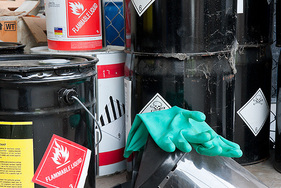
Small businesses across the
state are reducing their contributions to air pollution. A new Clean
Air Projects map highlights businesses
that have reduced volatile organic compounds (VOCs) or hazardous air pollutants
with help from Clean Air Minnesota.
These chemicals have been linked to adverse health effects, and scientists are
finding effects at lower and lower concentrations. Businesses that voluntarily
reduce air pollution are providing clear public health benefits. The map
shows who and where they are and pounds of pollution no longer being emitted.
If you are interested in making
changes at your business, there is funding and technical assistance available.
Check out the news story on Beairawaremn.org
for more information.
|
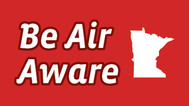 Help make the Be Air Aware website great while earning easy
money. The Be Air Aware web team has partnered with the web development company
High Monkey to evaluate the user experience of the website. Those chosen
to participate will be compensated with a $40 Visa card and some of the testing
is as short as 15 minutes!
Fill out this survey to throw your name in the hat, no previous
experience with the site is necessary. High Monkey is looking for people to
participate in activities that will help determine the best way to organize air
quality and health information. This process will help make it easier for
people to find the information they need on current air conditions, signing up
for air alerts, what they can do to protect their health, or if you represent a
business, finding grant money to make environmental changes.
Thank you for taking the time to help us!
|

Statewide and county air emissions data for 2008 and 2011 are available on the MPCA website in an interactive web tool. Users can explore interactive maps, charts and tables to view and compare statewide and county emissions for criteria air pollutants and air toxics.
Use this tool to:
- Explore types and volumes of air pollutants emitted by counties
- Explore the emission inventory by source types and categories
- Compare emission trends between 2008 and 2011.
|

Minnesota is a signatory to the Under2 Memorandum of Understanding, joining a
coalition of subnational governments in global climate leadership. The goal of
the MOU is to limit increases in average global temperatures to below
2° Celsius, which the Intergovernmental Panel on Climate Change scientists
say is needed to avoid the most dangerous consequences of climate change.
As part of Minnesota’s commitment to assess emissions and
track progress, the MPCA reported greenhouse gas emissions estimates and
progress toward our Next Generation Energy Act goals to the Compact of States
and Regions. The group’s annual
report demonstrates the aims and
achievements of states and regions and supports national commitments to address
climate change.
|
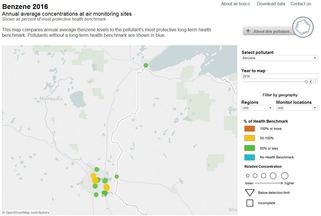
The Minnesota Air Toxics Monitoring web app provides
interactive access to annual air toxics monitoring summary results for over 70
air pollutants measured at monitoring sites across Minnesota. Using interactive
maps, charts, and data tables, the app allows users to explore how
concentrations of air toxic pollutants vary over space and time. The app is now
updated to include air toxics data between 2002 and 2016.
|
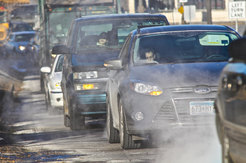
High-emitting
vehicles are passenger cars and light-duty trucks that emit high levels of
pollution into the air. These cars typically have outdated or broken emission
controls or exhaust equipment. Clean Air
Minnesota partner, Environmental Initiative, is launching a new pilot project
that aims to repair some of those broken technologies, improve fuel efficiency,
and reduce air pollution all at the same time.
Environmental
Initiative is partnering with two nonprofit garages that provide low-cost
safety and reliability repairs to help improve their clients’ economic
security. While funding is available, Cars for Neighbors and The Lift Garage
will offer no-cost repairs to three priority emission control systems on the
cars of clients that qualify for their services: catalytic converters,
evaporative emission control (EVAP) systems, and oxygen sensors. Learn more about the project on Environmental
Initiative’s website.
|

The Minnesota Technical Assistance Program is launching a
new project that will target efforts to reduce emissions of harmful air
pollutants in the Phillips community of Minneapolis. MnTAP will be reaching out to several small
and large businesses in the neighborhood to encourage the adoption of products
and processes that decrease hazardous air pollutants and VOCs, as well as fine
particulates, such as dust and fine sand. Staff will conduct site assessments and
advise interns to identify solutions at auto repair shops, janitorial services,
and healthcare facilities, among others. Project partners include the Lake
Street Council and Hope Community. The project is funded through a grant from
the EPA. For more information contact Jane Paulson, 612-624-1826, janep2@umn.edu.
|
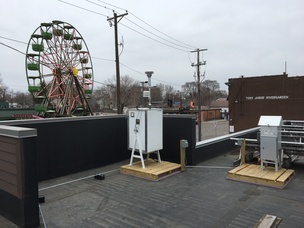
The
MPCA’s Community Air Monitoring Project uses funding from the Minnesota
Legislature to do short-term air quality monitoring in selected Minnesota
neighborhoods. The objective is to monitor and assess air quality in
low-income neighborhoods or communities of color that are disproportionately
impacted by air pollution from highways, air traffic, or industrial sources.
Since starting the project in October 2013, the MPCA has completed
monitoring in multiple communities in the Twin Cities and Duluth.
The
CAMP monitor is now located in the Bottineau/Marshall Terrace neighborhood in
Minneapolis. The monitor will measure common air pollutants such as fine
particles (dust and soot), VOCs, and metals that can be harmful to
breathe. Monitoring in this neighborhood started in January 2017 and is
expected to continue through mid-2018.
A summary report of monitoring from 2013-15
found that generally, except for a few areas where fine particles were slightly
elevated, pollutant concentrations in the CAMP-monitored neighborhoods were
similar to results from Minnesota’s permanent, statewide air-monitoring network.
However, monitoring in the St. Paul West Side community during the
spring of 2014 showed metals, while still within health benchmarks, were higher
than other Twin Cities monitoring sites. In response, the MPCA returned to the
West Side to do more metals monitoring in 2016. Results from this monitor, as
well as for the monitor located in South St. Anthony Park in St. Paul, should
be available on the website later this year.
After
the monitoring is complete, MPCA staff will analyze results, post the results
to the CAMP website, and share the findings with
the public. For more information on the Community Air Monitoring Project,
please visit the
website or
contact Kari Palmer at kari.palmer@state.mn.us or 651-757-2635. More
information about the MPCA’s air monitoring program is available here.
|
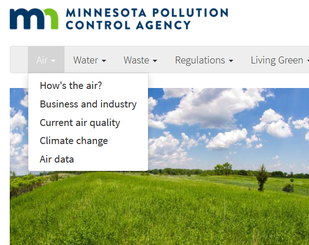
The MPCA recently overhauled our air web pages. It should be easier now to find information
about Minnesota’s air quality and the agency’s air regulatory programs.
The reorganization is the first phase in what eventually
will be a makeover of the agency’s entire website. With over 4,000 separate pages across all
programs, it had become difficult for users to find what they were looking
for. The purpose of the makeover is to
improve our site as a communication tool, and to get away from using it as a
giant filing cabinet into which users often had to dive way too deep in pursuit
of answers to even simple questions.
Now, MPCA web visitors looking for information about air
quality or air programs have a more common-sense way to find it. Click on the Air tab of the home page for a dropdown menu guiding
you to landing pages for:
-
How’s the air?
-
Business and industry
-
Current air quality (Air Quality Index)
-
Climate change
- Air data
“How’s
the air?” gives people general information on Minnesota’s air quality and
air pollution’s effects on our health.
It also explores what the MPCA does to understand our air and help
improve air quality. The new “Business and
industry” and “Air data”
pages should make it easier for permittees and clean-air advocates to find what
they need.
Over the next few months, we will continue to make updates. We encourage MPCA web users to take a tour of
the new air pages, and let us know what you think – we’re always open to suggestions
that can make it easier for visitors to navigate our website. Please send any comments to Ralph Pribble.
|

The MPCA’s What’s In My
Neighborhood application has been helping people find environmental
information for nearly 15 years. The agency’s switch to a new data and information
management system has made it possible for WIMN users to search for even more
data.
Launched in 2003, the original application provided users
with information about potentially contaminated properties only. In 2009, a
vastly expanded version was introduced, giving people access to information
about air emissions, wastewater discharges, and solid or hazardous waste
activities. The latest iteration makes some new program activities available to
users, including data about emergency management, environmental review, and
pollution prevention projects, to name a few.
If you have questions or comments about the application,
send us a note using the WIMN
feedback form.
|

The
Minnesota Pollution Control Agency is accepting applications from people interested
in serving as Minnesota GreenCorps members for the 2017-2018 year of the
program.
MN GreenCorps places AmeriCorps members with local
governments, non-profits, and educational institutions statewide to carry out
service projects on focused environmental topics. MN GreenCorps service is
full-time for approximately 11 months, beginning in September. For the 2017-2018 program year, members can
serve in positions in the areas of:
- Air quality (including energy conservation and green
transportation)
- Waste prevention and recycling
- Green infrastructure (including local foods, stormwater
management, and urban forestry)
- Living green outreach
MN GreenCorps members gain valuable skills and experience in
the environmental field while giving back to communities in Minnesota. Along
with a living allowance of $1,148 per month, members have the offer of health
insurance, loan forbearance, and upon completion, MN GreenCorps members receive
an education award of up to $5,815 that can be used for further education or to
pay off qualified student loans.
Member application materials and additional
information about the program are available on the MN GreenCorps website. Please direct questions to mngreencorps.pca@state.mn.us.
|
Air Mail is a quarterly,
email-based newsletter featuring updates on air quality issues and the work of
the MPCA and our partners. Subscribers to this list also receive Air Mail
Bulletins, which provide time-sensitive regulatory and technical updates.
To see past issues, Air Mail
Bulletins, or to subscribe, visit the MPCA's website.
If you have questions
or comments about Air Mail, please feel free to contact Amanda Jarrett Smith at
amanda.smith@state.mn.us.
|















